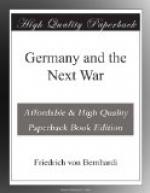The relations between the infantry and the artillery can naturally only be improved gradually by the strengthening of the infantry through the enforcement of universal service. The assignment of a fifth brigade to each army corps would produce better conditions than exist at present. But so soon as the strengthening of the infantry has gone so far that new army corps must be created, the artillery required for them can be taken from existing formations, and these can be diminished by this means. It will conduce to the general efficiency of the army if the artillery destined for each army corps is to some degree limited, without, however, reducing their total. Care must be taken that only the quantity of ammunition necessary for the first stages of the battle should be habitually carried by the columns of the troops engaged. All that exceeds this must be kept in the rear behind the commissariat waggons, and brought forward only on necessity—that is to say, when a battle is in prospect. The certainty of being able to feed the troops and thus maintain the rapidity of the advance is far more important than the more or less theoretical advantage of having a large quantity of ammunition close at hand during the advance. The soldiers will be inclined to be sparing of ammunition in the critical stages of the fight, and will not be disposed to engage with an unseen enemy, who can only be attacked by scattered fire; the full fire strength will be reserved for the deciding moments of the engagement. Then, however, the required ammunition will be on the spot, in any event, if it is brought forward by stages in good time.
A suitable organization of the artillery would insure that each division had an equal number of batteries at its disposal. The light field howitzers, however, must be attached to a division in such a way that they may form an artillery corps, without necessarily breaking up the formations of the division. The strength of the artillery must be regulated according to that of the infantry, in such a way that the entire marching depth does not exceed some 25 kilometres. The heavy field howitzers, on the other hand, must in peace be placed under the orders of the General commanding, and in event of war be combined as “army” artillery.
It would, perhaps, be advisable if the cavalry were completely detached from the corps formation, since the main body is absolutely independent in war as “army” cavalry. The regiments necessary for service with the infantry could be called out in turn during peace-time for manoeuvres with mixed arms, in order to be trained in the work of divisional cavalry, for which purpose garrison training can also be utilized. On the other hand, it is, I know, often alleged that the Truppenfuehrer are better trained and learn much if the cavalry are under their orders; but this objection does not seem very pertinent.




